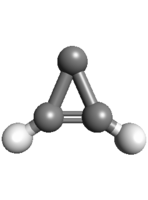Cyclopropenylidene, deuterated isotopolog with 13C on C3
 | |
|---|---|
| Species tag | 040518 |
| Version | 1* |
| Date of Entry | Dec. 2015 |
| Contributor | H. S. P. Müller |
|
The transition frequencies were taken from | |
| Lines Listed | 144 |
| Frequency / GHz | < 300 |
| Max. J | 6 |
| log STR0 | -7.0 |
| log STR1 | -4.5 |
| Isotope Corr. | -5.77 |
| Egy / (cm–1) | 0.0 |
| µa / D | 0.99 |
| µb / D | 3.12 |
| µc / D | |
| A / MHz | 33807.3 |
| B / MHz | 26551.8 |
| C / MHz | 14832.3 |
| Q(300.0) | 45660.6943 |
| Q(225.0) | 29653.1926 |
| Q(150.0) | 16143.0862 |
| Q(75.00) | 5714.1669 |
| Q(37.50) | 2026.2769 |
| Q(18.75) | 720.9055 |
| Q(9.375) | 258.1596 |
| Q(5.000) | 102.8622 |
| Q(2.725) | 43.1385 |
| detected in ISM/CSM | not yet |